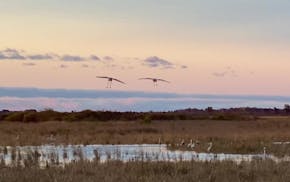Before Rachel Evangelisto took the stage at the Miss Minnesota pageant on Friday, she decided to smudge.
Evangelisto uses the practice of smudging, which is taking the smoke from Indigenous-grown burnt sage and leaves and running it over herself and others, to center her mind. It is an important part of her Indigenous heritage and culture, she said, typically used to cleanse the soul.
So Evangelisto, the first Indigenous woman to hold the title of Miss Winona, gathered with Lori Martin-Kingbird, another Indigenous competitor, to perform the prayer.
"We sat down," Evangelisto said. "We just prayed with one another and said like, if it's not me, I hope you so that we can see the representation that we know our people need."
When Evangelisto's name was announced as the winner at the end of the evening amid fireworks, she cried. She had become the first Indigenous woman to be crowned Miss Minnesota in the state pageant's history.
"It was incredible, and overwhelming and just awesome," she said. "I started sobbing because I realized, like, this was so hard to get here. I cannot believe this has happened."
Embracing her Indigenous heritage wasn't always easy. As a child, Evangelisto often told people that she was Italian to avoid backlash from her peers.
It was not until she began school at the University of Minnesota, Morris, for her undergraduate degree, she said, that she started to see more Indigenous representation and felt more confident discussing her identity.
Evangelisto, who is Húŋkpapȟa Lakota and an enrolled member of the Standing Rock Sioux Tribe, hopes to use her role as Miss Minnesota to empower young Native Americans.
She works as an Indian Child Welfare Act guardian, where she is a court-appointed advocate for Indigenous children involved in foster care and child protection. She plans to attend Mitchell Hamline School of Law in the fall and said she hopes to represent Indigenous children as an attorney.
Lt. Gov. Peggy Flanagan tweeted her congratulations, saying it's "so exciting to have a Native woman representing our state!"
Upper Sioux Community tribal secretary Adam Savariego, who is Evangelisto's friend, said he hopes that eventually, Indigenous success will not be viewed as radical.
"It's almost [like] a barrier was removed, because now it is shown as possible," he said. "Showing up in places particularly in the public view — unapologetically of who you are — is probably the most important idea of the representation itself."
Evangelisto, 25, has enrolled in pageants since she was a child in Aberdeen, S.D. When she started, she said, she did not have a lot of support, but that motivated her to work harder.
"I wanted to prove to people that I was capable of something," she said. "My family was not well off. ... Teachers and other adults in my life never really thought that I was going to amount to much. And that really defined my childhood and who I eventually became."
In high school, when Evangelisto did not have enough money to have someone tailor her dresses, she learned to do it herself.
She moved to Minnesota at age 18 and has earned over $26,000 in pageant scholarships.
The Miss Minnesota organization is "thrilled to crown our first Indigenous woman after 86 years!" spokeswoman Vicki Kueppers said in an e-mail. "Rachel will be an exemplary representative of her culture and community as she works to promote her message of celebrating culture and driving diversity."
Evangelisto will compete in the Miss America competition in Connecticut in December. Until then she will work to visit the 11 tribal nations in the state.
"To be the first Native American Miss Minnesota is a really big deal, and the pressure that comes with that is massive," she said. "I may be the first but I most certainly do not want to be the last."

Want to share info with the Star Tribune? How to do it securely

A Minnesota field guide to snow shovels: Which one's best?
Sign up for Star Tribune newsletters

